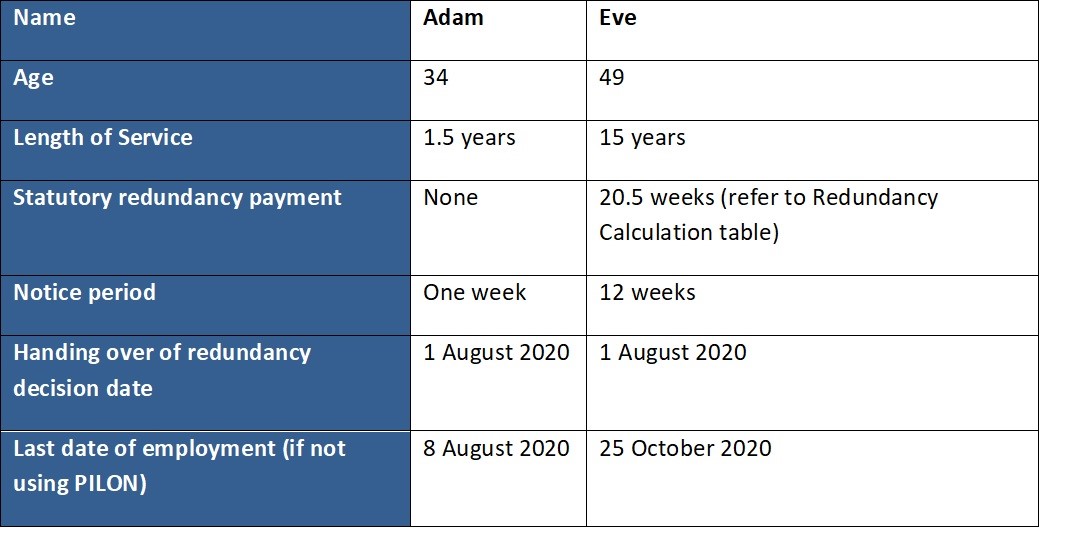Exploring the Interplay In Between Business Redundancy and Organizational Adaptability for Future Development
In the dynamic landscape these days's company globe, the elaborate partnership between firm redundancy and organizational flexibility emerges as a crucial aspect for continual growth and success. Firms frequently encounter the challenge of striking a fragile balance between keeping a level of redundancy to alleviate threats and fostering versatility to react swiftly to the ever-evolving market demands. This fragile interplay holds the essential to not just surviving in rough times yet also prospering despite uncertainty. As we check out the complex measurements of this interplay, interesting understandings right into just how organizations navigate these complexities to lead the way for future growth await.
Significance of Business Redundancy
Business redundancy is a vital aspect that improves organizational durability and reduces operational risks. By incorporating redundancy steps within the organizational framework, firms can much better hold up against unpredicted disturbances and variations in the service atmosphere. Redundancy acts as a tactical buffer, permitting firms to adjust and respond effectively to unexpected obstacles without endangering necessary operations.
One key facet of the value of business redundancy is its role in ensuring connection throughout times of crisis. When faced with abrupt modifications or emergencies, repetitive systems, resources, or personnel can tip in to preserve essential features and stop widespread disturbances. This continuity not just safeguards the business's credibility and consumer depend on but additionally reduces economic losses and operational downtime.

Techniques for Organizational Adaptability

Developing versatile organizational structures that allow for fast changes to market dynamics and customer needs is crucial for remaining affordable in a quickly developing environment. By proactively determining prospective interruptions and opportunities, companies can proactively grow and adjust in an ever-changing company landscape.
Harmonizing Redundancy and Adaptability
Accomplishing a harmonious stability between functional redundancy and business adaptability is extremely important in browsing the complexities of a vibrant business setting. Redundancy within a business provides a safeguard, making certain continuity and security in operations. Nonetheless, an extra of redundancy can bring about ineffectiveness and prevent versatility to transforming market conditions. On the various other hand, organizational versatility allows firms to react quickly to exterior disruptions and take brand-new opportunities. Striking the appropriate balance between redundancy and flexibility is a delicate process that calls for a deep understanding of the organization's goals, sector dynamics, and danger resistance.
To achieve this equilibrium, firms need to perform routine evaluations of their operations to identify locations where redundancy is essential for threat reduction and where flexibility can drive technology and development. Applying adaptable frameworks, promoting a culture of continuous learning and improvement, and urging open interaction throughout all levels of the organization are key strategies to integrate redundancy and flexibility successfully. By lining up these two crucial elements, firms can place themselves for sustainable development and success in an ever-changing organization landscape.
Situation Research Studies on Adaptation Success
In examining circumstances of effective organizational adaptation, it comes to be obvious that the interplay in between functional redundancy and adaptability is a defining consider forming durable companies. One engaging study is that of Netflix. Initially a DVD rental solution, Netflix demonstrated impressive versatility by transitioning into a streaming system when digitalization interrupted the industry. By tactically purchasing modern technology and material creation, Netflix not just survived yet flourished in a rapidly advancing market. One more standout example is Amazon. Beginning as an on the internet bookstore, Amazon continually adapted its organization design, increasing into diverse markets such as cloud computing and fabricated intelligence. This adaptability enabled Amazon to remain ahead of rivals and satisfy transforming customer needs. Finally, Adobe provides a significant image of effective adjustment. The firm shifted from marketing software licenses to a subscription-based design, ensuring persisting earnings streams and enhanced customer interaction. These instance studies highlight the value of functional redundancy coupled with organizational flexibility in cultivating long-term growth and competitiveness.
Building Resilience for Future Growth
Building resilience for future growth requires a critical placement of functional procedures with market characteristics and arising patterns. Business should adapt to transforming settings by fostering a society of adaptability, technology, and constant enhancement. Resilience involves not just getting better from obstacles however also proactively planning for future difficulties. One essential aspect of structure strength is investing in robust threat administration great site techniques to reduce potential disturbances. This consists of scenario preparation, diversifying supply chains, and developing contingency prepare for numerous contingencies (who pays redundancy money).
Additionally, fostering strong relationships with stakeholders, such as clients, staff members, providers, and the area, is necessary for maintaining and weathering uncertainties trust fund and support during stormy times. Effective interaction and see this site openness play an important function in structure resilience, as they assist straighten expectations and help with partnership in browsing unpredictabilities.
Additionally, companies require to focus on knowing and advancement campaigns to upskill employees and furnish them with the essential tools to adapt to altering conditions. By investing in their workforce, business can boost their flexibility and agility, ultimately enhancing their durability for lasting future development.
Verdict

In the dynamic landscape of today's service world, the detailed connection between home firm redundancy and business flexibility emerges as an essential factor for continual development and success. Firms typically face the challenge of striking a delicate equilibrium between keeping a level of redundancy to mitigate risks and cultivating versatility to respond promptly to the ever-evolving market demands.To accomplish this equilibrium, business need to perform routine evaluations of their procedures to identify locations where redundancy is needed for risk reduction and where versatility can drive innovation and growth.In final thought, the interaction between company redundancy and business adaptability is crucial for future growth. Structure strength via a combination of redundancy and flexibility will make sure that companies are prepared for the obstacles of the future.